Dread Monsters and Sinister Menaces: The Worlds of James H. Schmitz
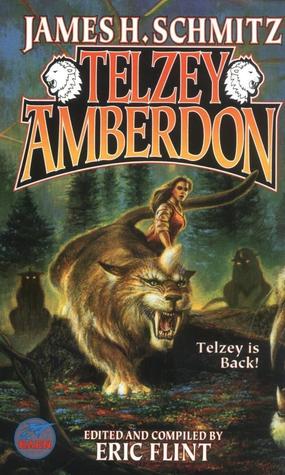 |
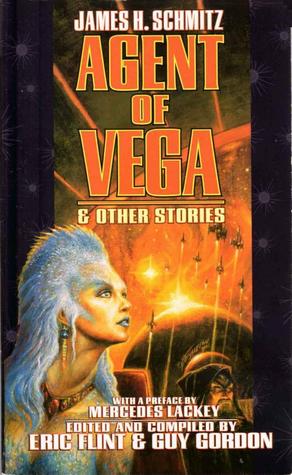 |
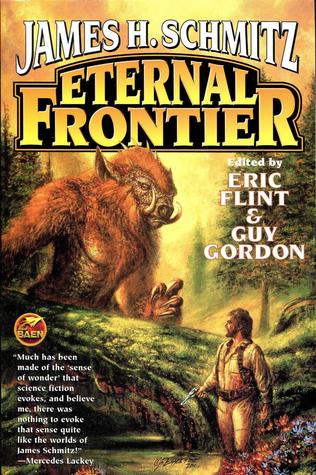 |
Three Bean omnibus reprint volumes featuring James H. Schmitz:
Telzey Amberdon, Agent of Vega and Other Stories, and Eternal Frontier
(March 2000, November 2001, September 2002). Covers by Bob Eggleton
Two years ago I created a Facebook post about a Black Gate Vintage Treasures article on James H. Schmitz’s 1979 novel Legacy. One of the interesting things about Facebook is that you’ll occasionally get comments years later, and that’s what happened this time. On November 3rd of this year Allan T. Grohe Jr. responded to that ancient post with two intriguing questions for me.
John: do you know of any 1/ interviews with Schmitz? — other than the one in Moebius Trip #15 from 1972, which I’m aware of but seems pretty difficult to find, or 2/ literary studies of Schmitz’s works?
I first read Schmitz about 15 years ago, via Eric Flint’s Baen collections, and he ranks up there with Herbert as a worlds-builder, in my estimation! 🙂
Unfortunately I don’t know of any interviews with, or studies of, James Schmitz. But that comment did lead to a broader and very rewarding conversation with Allan, in which I learned about his own writing on Schmitz.
[Click the images for sinister versions.]
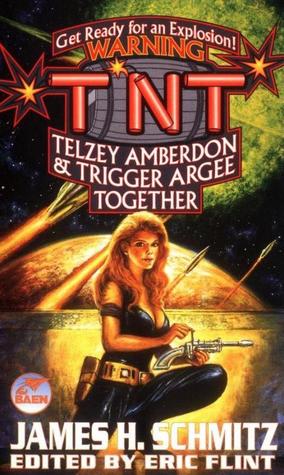 |
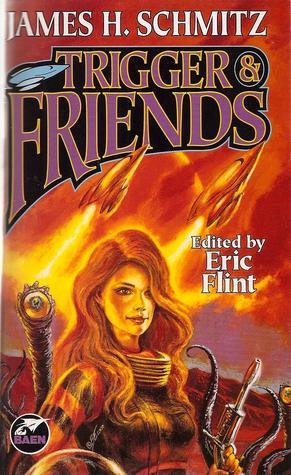 |
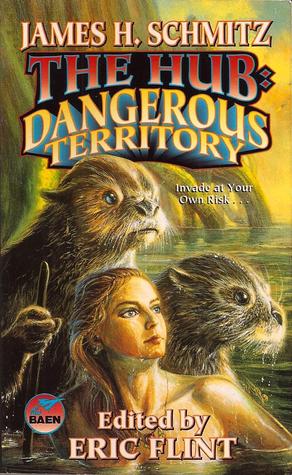 |
Three more Bean volumes: T’nT: Telzey & Trigger, Trigger & Friends, and
The Hub: Dangerous Territory (July 2000, January 2001, April 2001). Covers by Bob Eggleton
Back in 2017 Allan was a guest at Timothy Connolly’s column at TSR’s Multiverse blog, where he discussed GRODOG’S 7 OF THE BEST MYTHIC WORLDS BUILDERS.
His roll of honor included J. R. R. Tolkien, Frank Herbert, the artist Roger Dean — and of course, our man James Schmitz. Here’s Allan:
James H. Schmitz – Schmitz’ space opera universes of The Hub and The Confederacy of Vega are primarily defined through short stories and novellas. They reveal his vision for a humanity that is independently capable, diversely diasporic, and always rises to the trials before it. His science fictions are tales of hope, equality, perseverance, individuality, and victory against seemingly-insurmountable odds — a vision uniquely his own, filled with the many interleaving relationships between and across characters, organizations, planetary systems, and species. Most of his work was OOP and hard-to-find until Baen reprinted them in new collections edited by Eric Flint in the early- to mid-2000s; the first is Telzey Amberdon.
Telzey Amberdon and Eternal Frontier are both still in print, more than two decades after publication, though the other Schmitz collections are getting hard to find.
Why is James Schmitz so fondly remembered today?
I think Gardner Dozois had the best explanation (as is often the case). In his introduction to “Second Night of Summer” in the marvelous anthology The Good Old Stuff, he nicely summed up the enduring appeal of Schmitz’s fiction.
Although he lacked van Vogt’s paranoid tension and ornately Byzantine plots, the late James H. Schmitz was considerably better at people than van Vogt was, crafting even his villains as complicated, psychologically complex, and non-stereotypical characters, full of surprising quirks and behaviors that you didn’t see in a lot of other Space Adventure stuff… And his universes, although they come with their own share of monsters and sinister menaces, seem as if they would be more pleasant places to live than most Space Opera universes, places where you could have a viable, ordinary, and decent life once the plot was through requiring you to battle for existence against some Dread Implacable Monster; Schmitz even has sympathy for the monsters, who are often seen in the end not to be monsters at all, but rather creatures with agendas and priorities and points-of-view of their own, from which perspectives their actions are justified and sometimes admirable — a tolerant attitude almost unique amidst the Space Adventure tales of the day, most of which were frothingly xenophobic.
Similarly, Schmitz was decades ahead of the curve in his portrayal of female characters — years before the Women’s Movement of the ’70s would come along to raise the consciousness of SF writers (or attempt to), Schmitz was not only frequently using women as the heroines in swashbuckling tales of interplanetary adventure — itself almost unheard of at the time — but he was also treating them as the total equal of the male characters, every bit as competent and brave and smart (and ruthless, when needs be), without saddling them with any of the “female weaknesses” — like an inclination to faint or cower under extreme duress, and/or seek protection behind the muscular frame of the Tough Male Hero) that would mar the characterization of women by some writers for years to come.
The Gool Old Stuff, and its companion volume The Good New Stuff, are two of my all-time favorite anthologies, and well worth the effort to track down (the latter is still available at Amazon, 24 long years after it was first published).
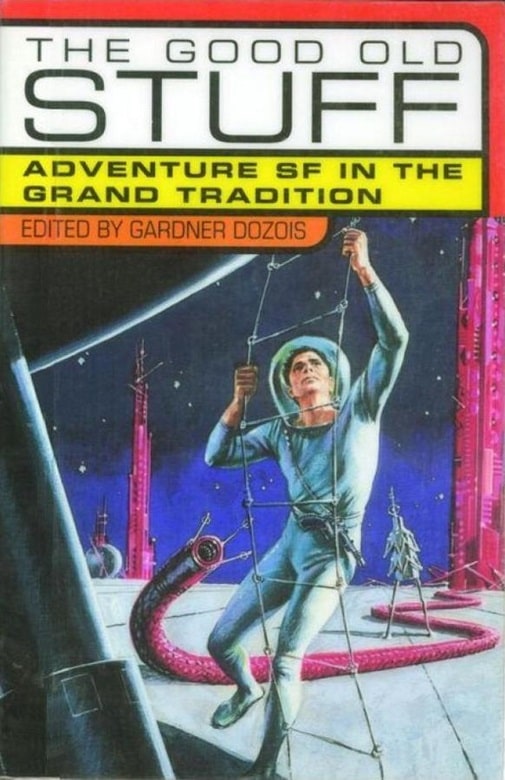 |
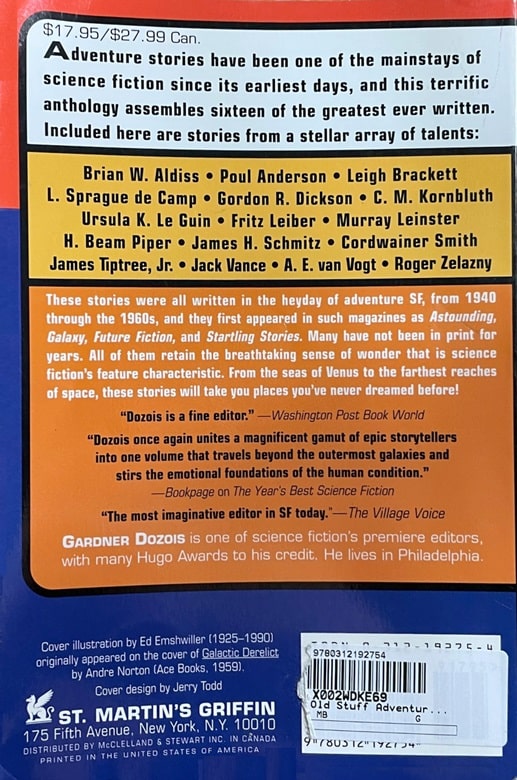 |
The Good Old Stuff: Adventure SF in the Grand Tradition
(St. Martin’s Griffin, December 1998). Cover by Ed Emshwiller
James H. Schmitz was one of the finest science fiction writers of the 20th Century — and certainly one of the most unjustly overlooked today. The Baen paperback omnibus volumes, assembled and edited by Baen senior editor Eric Flint, collected the bulk of his work in handsome and highly affordable volumes. There were a gift to science fiction fans, and if you haven’t discovered them, I urge you to give them a look.
Telzey Amberdon (March 2000, 436 pages, $6.99, cover by Bob Eggleton) — includes the novel The Lion Game (1971)
T’nT: Telzey & Trigger (July 2000, 403 pages, $6.99, cover by Bob Eggleton)
Trigger & Friends (Jan 2001, 480 pages, $6.99, cover by Bob Eggleton) — includes the complete novel Legacy (1962)
The Hub: Dangerous Territory (April 2001, 473 pages, $6.99, cover by Bob Eggleton) — includes the complete novel The Demon Breed (1968)
Agent of Vega & Other Stories (Nov 2001, 567 pages. $7.99, cover by Bob Eggleton)
Eternal Frontier (Sept 2002, 727 pages. $7.99, cover by Bob Eggleton) — includes the complete novel The Eternal Frontiers (1973)
The Witches of Karres (Nov 2005, 394 pages. $7.99, cover by Kurt Miller)
Our recent coverage of James H. Schmitz includes:
Back to the Future: Modern Reprints of Classic Fantasy by Rich Horton (2010)
A Review of The Witches of Karres by Isabel Pelech (2010)
James Schmitz’s The Demon Breed: SF as a Test-bed for Living (With Women who Kick Alien Butt) by Mark Tiedemann (2011)
Vintage Treasures: The Witches of Karres (2014))
The Omnibus Volumes of James H. Schmitz (2015)
Vintage Treasures: The Demon Breed (2016)
Birthday Reviews: James H. Schmitz’s “The Vampirate” by Steven H Silver (2018)
Vintage Treasures: Legacy (2021)
See all of our recent Vintage Treasures here.
I snapped up all of these as soon as they were published. Good old stuff indeed!
Eric Flint did some really extraordinary editorial work at Baen. Not just these books, but also the wonderful omnibus volumes from Murray Leinster, Andre Norton, Lois McMaster Bujold, P. C. Hodgell, A. Bertram Chandler, and many others. He kept an entire library of classic SF in print for a whole new generation.
I like Mr. Schmitz’s work, maybe due to the unbeatable title of his collection A Nice Day for Screaming and Other Tales of the Hub. Thank you, Chilton! Our monthly sf/f reading group is doing The Witches of Karres for January, so I am looking forward to seeing how well it holds up for a re-read.
Eugene,
That is a great title! I wasn’t aware of that collection for many years — probably because it never had a paperback reprint.
It’s a hard get these days — the price on for this book on eBay ranges from $120 – $750.
https://www.ebay.com/sch/i.html?_from=R40&_trksid=p2334524.m570.l1313&_nkw=%22A+Nice+Day+for+Screaming%22
Luckily, I read it back in the day. Unluckily, that day was in 1970 or so, so I probably need the Baen collections to revisit the Hub.